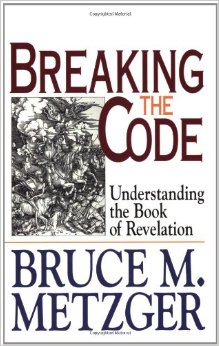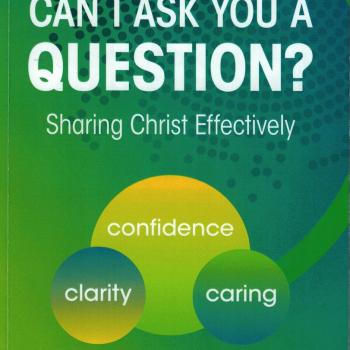Breaking the Code: Understanding the Book of Revelation by Bruce Metzger
INTRODUCTION
The book of Revelation seems to many people an enigma. The book is laden with symbols and pictures that are hard to define. Many of the ideas and characters take on a form of mystery that intrigues almost all Christians. In this book, the author presents in a verse-by-verse fashion, the meaning of the book of Revelation. It is a well-written summary of the interpretation of Revelation. The book serves as a good primer for the novice student of prophecy. As stated in the Preface, the Bruce Metzger has tried to present a scholarly as well as a devotional approach to Revelation. The book has in mind the needs and interests of the general non-theological reader.
BREAKING THE CODE
Metzger introduces the book by giving a thorough in-depth look at the background, genre, authorship, date, and purpose of Revelation. The most interesting insight in this chapter is the reasoning that is used to approach the interpretation of Revelation. Metzger makes the point that it is “important to recognize that the descriptions in Revelation are descriptions of symbols, not of the reality conveyed by those symbols.” Through the rest of the book, Metzger gives an expository approach to Revelation. Each chapter deals with a section in Revelation. In eleven concise chapters, Revelation is opened and dissected for the reader.
Chapter two deals extensively with the prologue of Revelation. Details about the Christ in Revelation are presented. God is the source of Revelation, and is presented to Jesus, then to an angel and finally to John. The letters are written in their specific order, not because they represent the history of the churches. They are the most natural progression a letter would move by a messenger from the island of Patmos. The divinity of Jesus is explained in the first chapter of Revelation: (1) Christ is in the midst of His churches, (2) Christ is king, (3) Christ is wise, (4) Christ’s eyes can see our hypocrisy, (5) Christ is strong and stable, (6) Christ has the words of a prophet, (7) Christ holds the angels of the church, (8) Christ has the word of judgment, and (9) Christ shines above all else. The divinity of Jesus is further defined by the names attributed to Him (“First and Last,” “Living One,” “has the keys to death and Hades.”)
The book continues through chapter three with letters to seven different churches. Seven is symbolic of completeness, and these letters were written to specific churches as well as to all churches. There is a pattern in these letters: (1) identification of Christ, (2) letter is addressed to a particular angel, (3) Jesus knows the problems in the churches, (4) a condemnation or commendation is given, (5) an appeal to what the Spirit says to the churches. Metzger discusses in a pattern details about the letters to the churches. First, he talks about the culture of the churches. Second, he discusses the corrupting influence that was around the churches. Mostly, these were Greek or Roman religious practices. He then presents the problem that each church encounters. He shows the result of the problem, and then the solution. Finally, the promise is given to the faithful overcomers.
From the “open door” to the churches, Metzger describes John’s next vision the open door to Heaven. While chapter three of Revelation deals with Christ to the church, chapter four deals with the Christian to God. The ideas such as the throne room, the elders, the angels, the four creatures, and the description of the Lamb are all discussed and all their interpretive options presented. Worship, which is the primary emphasis in these two chapters are discussed.
Beginning with chapter six and ending in chapter eleven of Revelation, there is the struggle of the church amid conflict and persecution, and also the judgments of God upon the enemies of the church. The judgments begin with the seals, and Metzger goes into good detail concerning the identity of the first four seals, common known as the “Four Horsemen of the Apocalypse.” Metzger takes such as an idealist approach to Revelation that at the sealing of the 144,000 after the first six seals, he carefully omits reference to who that could be.
With the trumpet judgments, Metzger begins to do some comparison and contrast. The first four are judgments rendered upon all humanity through the powers of nature. The next three are demonic in activity After the trumpets come the thunder judgments which are delayed. Here, Metzger compares the results of the thunder judgments to Paul’s experience in his vision of Heaven in 2 Corinthians. In that case, Paul is permitted not to tell what he has seen. In the same fashion, John is permitted not to tell what the judgments are. The scroll is defined as the message by God to John, a prophecy that he is given to tell the churches.
The images of the temple and the two witnesses are presented in Revelation in the same chapter to relate the mission of the church. By means of symbolism Revelation focuses on the security of the church’s true life and the safety of the “temple,” which cannot be touched. Continuing with chapter twelve, Revelation begins to “flash back” to tell more of the story of the end. The Satanic trinity is presented: the dragon and the two beasts. In this passage, the dragon is presented in a much more fuller picture than the rest of the Bible. The dragon has an eagerness to devour the child which explains the violent opposition that Jesus met during His earthly ministry. The child that is “snatched away” represents His ascension.
Each of the members of the counterfeit trinity are representative of the Roman Empire. The world power utters blasphemies against God through the imperial cult. Emperors were deified and given the status due only to God. The “mark” is a manner of conforming to the demands of the state. The “number of the beast” is the symbol of the greatest imperfection.
Following the counterfeit trinity, there is an interlude to reassure the readers of Revelation. There are a series of security presented after frightful scenes of horror. The 144,000 are the ones who have not committed fornication, in this case, participating in pagan worship. The most terrible thing a person could do was to deliberately turn away from God. Revelation was written to prevent this danger in the churches.
Next comes the seven bowl judgments that are given to the entire unrepentant world. The spiral continues with the fall of the world system and the false religious system, Babylon. Babylon is the imperial cult that impugns upon every Christian. This begins with the song of the martyrs. Noticeably, there is no mention of the victory by the martyrs, only by God. Armageddon, a mystery in the literal interpretation, is presented as the final battle of history. The harlot is the Roman imperial system that commits fornication with the other states that are aligned with her politically. She has the blood of the saints as her drink in her “golden cup.” This is clearly a reference to the persecution of the church by Nero. This is John’s form of political cartoon. Chapter eighteen ends with the end of the Roman imperial power.
In contrast to the imperial funeral dirge of chapter eighteen, the rest of the book of Revelation presents the consummation of God’s reign on earth. The picture begins with conquest and ends in marriage. The conquest includes the marriage supper of the Lamb where the nations of the world are killed and gorged by vultures. The events are not literal. But the symbolism is clear. The death of the evil empire and its domination on this world is the beginning of the rule of Christ as the Savior and Judge. It is noteworthy that the victory is won by Christ’s word alone without any military help of the faithful. This is another contrast with other apocalyptic literature of the time (where the leader needs the help of his followers to achieve victory.)
Following this comes the account of the millennium. There are many questions that literally are left unanswered in the text. Satan is bound and then released only to deceive more people and then be destroyed. God and Magog are destroyed, but the nations that participate are innumerable. Any attempt to define the nations that participate are missing the point of the chapter. The time is one thousand years, clearly a longer time than the Roman empire would be in existence. At this point, Metzger defines the different interpretations of the millennium. The final judgment follows the millennium. All of the people are judged based on their belief in Jesus. The account of the judgment is brief, but is one of the most impressive descriptions of the Final Judgment ever written. This clears the way for the establishment of the new heaven and the new earth.
The final chapter in this book deals with John’s vision of the heavenly Jerusalem. The chapter gives details concerning the meaning of the symbolism used in this final part of Jerusalem. The essence of this time will be that people of God will be in the presence of God. They will know God. To the degree that our spiritual perception is refined here on earth, will determine the degree we see God in Heaven.
The book ends with a discussion of the epilogue and the importance of imminence. In the Christian doctrine of last things, the imminence of the end is moral, not chronological. Each generation may be the last generation.
CONCLUSION
The book of Revelation provided pastoral encouragement for Christians who were confronted with persecution and cruelty. Metzger does well in keeping that theme. In a little more than one hundred pages, he gives a concise understanding for the beginning student of prophecy. As is noted throughout the book, Revelation is not just a time-line of the end. Revelation is meant to encourage, strengthen, and give hope to Christians who are living in this world, but not of it. Victory is the theme, no matter the circumstances. Metzger gives a list of further reading at the end of his book, which should be in every prophecy students’ library. His book should also be included. It is concise and precise. It is theologically sound, instead of chronologically confused. This book is a good compliment to the study of Revelation.













